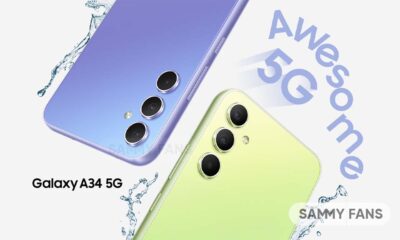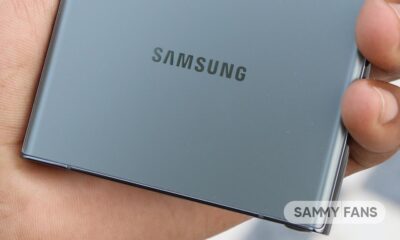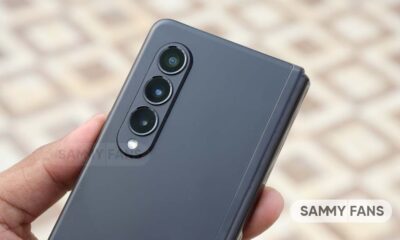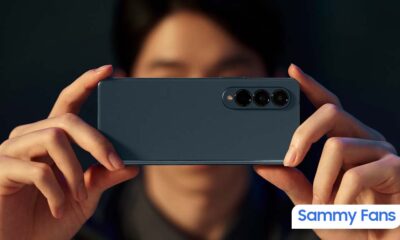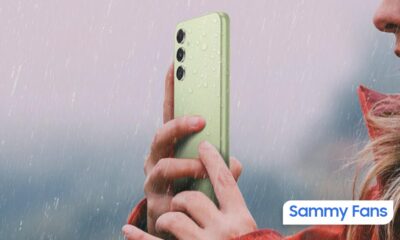Tips
How to organize the Home Screen of your Samsung Galaxy devices
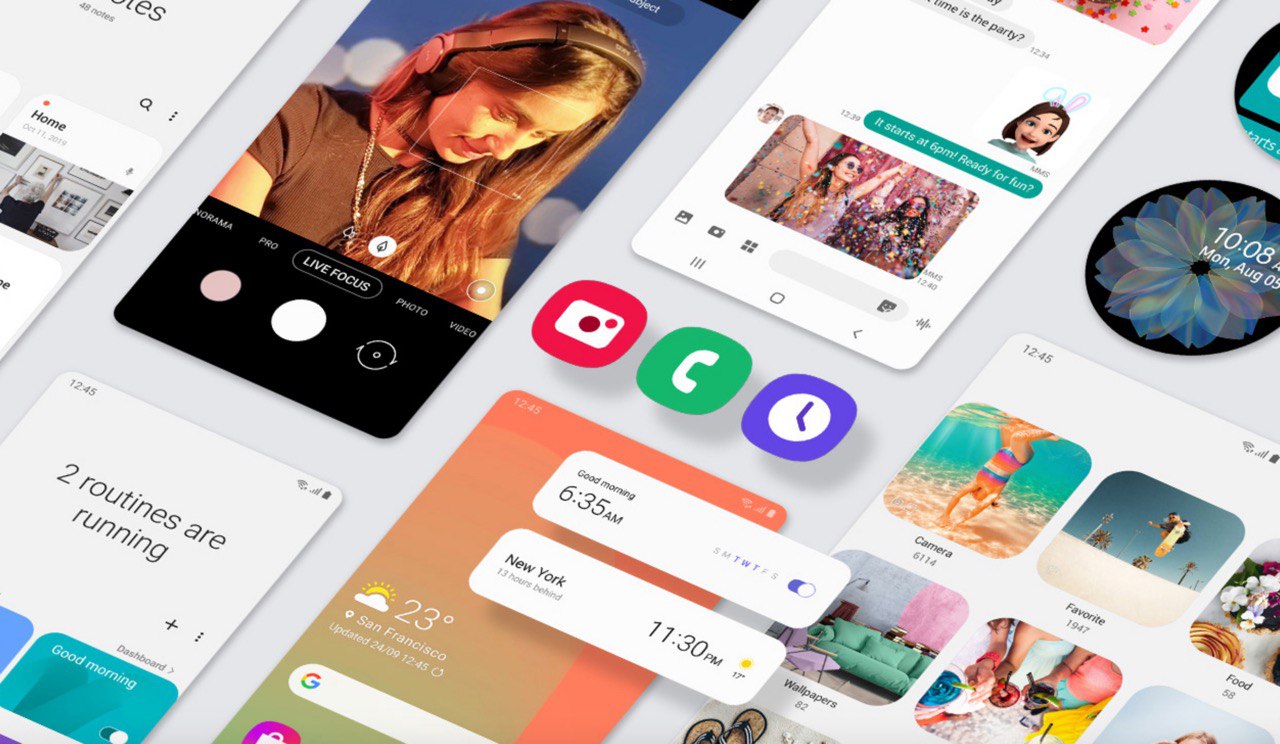
Everyone loves a comfortable and clean home and that applies to your phone as well. No worries, you can customize and style your phone’s Home screen by changing the screen orientation, or adding widgets, folders, and extra Home screens. It will make your phone more organized and easy to navigate.
You can customize the Home screen and also the application drawer. It also comes with an enhanced screen layout, neatly arranged icons, as well as Home and Apps screens that perfectly fit Galaxy devices. That also has a blurred background option and page looping for the app drawer, and more.
Note: Available screens and settings may vary by the wireless service provider, software version, and phone model.
Read More: Samsung One UI 3.0 beta starts rolling out in Poland for Galaxy S20 series
Landscape Home Screen
By default, Galaxy phones are set to Auto-rotate so the phone will automatically adjust its display mode based on how you are holding it.
You can also lock the screen in Landscape mode if needed. Just turn your phone sideways, and open the Quick settings panel by swiping down from the top of the screen. Tap Auto-rotate, the phone will now be locked in Landscape mode. To go back to Auto-rotate, simply tap Landscape in the Quick settings panel.
Do you want your Home screen to rotate to landscape too:
- To do this, navigate to Settings, and then tap Display.
- Tap the Home screen, and then tap the switch next to Rotate to landscape mode.
You can also make your Always On Display appear in Landscape mode if you prefer.
- From Settings, tap Lock screen, and then tap Always On Display.
- Tap Rotate the screen to and then tap Landscape. Now your AOD will always display in Landscape mode.
Add or remove widgets
Widgets are like mini versions of apps. They appear on your Home screen and when you tap them, they will activate or use an app’s feature. These super-powered shortcuts will help you access your favorite apps faster.
- To add a widget, swipe to a Home screen. Then, touch and hold an empty spot.
- Tap Widgets, select your desired widget and then drag it onto the Home screen.
- To remove a widget, just touch and hold the widget, and then tap Remove from Home.
There are a few options available after you’ve placed your widget. User, please keep in mind the options may vary depending on the widget, as well as, it may vary on your devices.
- Resize: Widgets that can be resized will have a blue line along its edges. You can resize it by touching and dragging the lines.
- Color: Set your widget to a different color. You can access this by touching and holding the widget and then tapping Widget settings.
- Transparency: Increase or decrease the widget’s transparency so you can easily see it. You can access this by touching and holding the widget and then tapping Widget settings.
Organize your Home screen
You can customize and style your phone’s Home screen. Here are some examples you can follow to keep your Home screens neat and clean:
- You can remove unwanted apps from your Home screen by tapping and holding your desired app.
- Then, tap Remove from Home to delete the shortcut. Or, you can tap Uninstall to remove the app from your phone entirely.
- You can drag the Samsung Apps folder onto the Home screen to quickly access the Samsung apps you need.
- You can also organize the apps into digital folders on your Home screen. Just drag one app on top of another app to make a folder.
If needed, you can add more Home screens to your phone. It’s a great way to organize all your apps and folders.
- Tap and hold an empty area on your Home screen.
- Swipe until you reach a blank Home screen and then tap Add to create a new one.
- To remove an extra Home screen, swipe to that screen, and then tap the Delete icon.
- Tap Delete again to confirm.
Note: The coloring feature may vary based on the model and software.
Tips
How to create and use Secure Folder in Samsung Galaxy
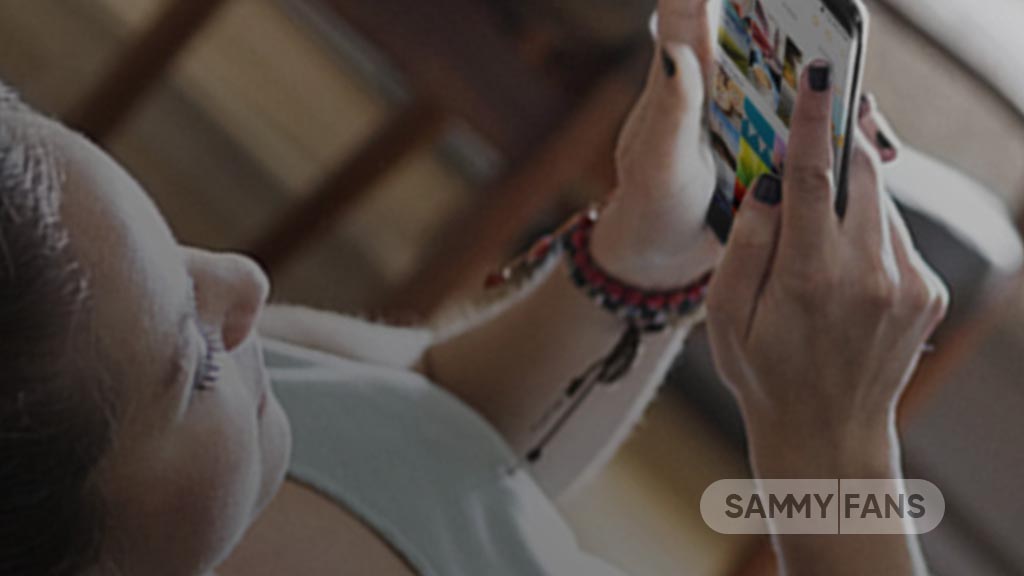
Samsung Galaxy phones come with a Secure Folder feature for enhanced data protection. It works as a dedicated compartment in your Galaxy smartphone where you can store different kinds of files (photos, videos) and installed applications.
The Knox technology provides layers of security and privacy, not only to protect users but also to give them a choice in what they want to secure. For those who want to keep their most personal information separate and safe, there’s Secure Folder.
Photos, videos, and files stored in Secure Folder won’t be accessible in regular apps. If you need them, you have to access the Secure Folder – authentication required. It takes the security and user privacy to a whole new level and the data is secured by Samsung on-device.
Secure Folder can keep your most private data such as calendar schedules and contact info, as well as notes, photos, videos, files, and even apps. You can even encrypt the Secure Folder to keep your apps and data even more locked down until the next time you open the folder.
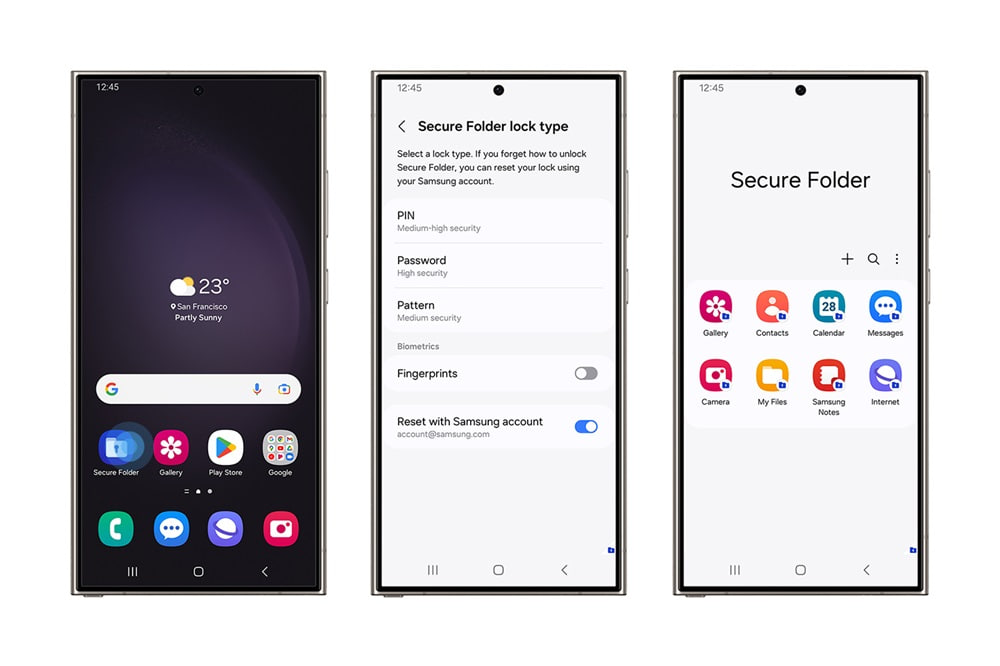
You can find Secure Folder in your apps.
The first time you open it, you’ll have to set your lock type to either a PIN, pattern, or password, with fingerprint authentication can be enabled as well. Anything you create within the Secure Folder will be automatically stored here, but you can also move data here at any time.
For instance, if you want to keep a copy of your driver’s license, you can take a photo of it using the Camera app within Secure Folder, or you can pick a photo in your Gallery, tap the options menu (the three dots) and then select ‘Move to Secure Folder.’
Stay up-to-date on Samsung Galaxy, One UI & Tech Stuffs by following Sammy Fans on X/Twitter. You can also discover the latest news, polls, reviews, and new features for Samsung & Google Apps, Galaxy Phones, and the One UI/Android operating system.
Do you like this post? Kindly, let us know on X/Twitter: we love hearing your feedback! If you prefer using other social platforms besides X, follow/join us on Google News, Facebook, and Telegram.
One UI 6.1
Samsung One UI 6.1 Advanced Motion Photo Feature
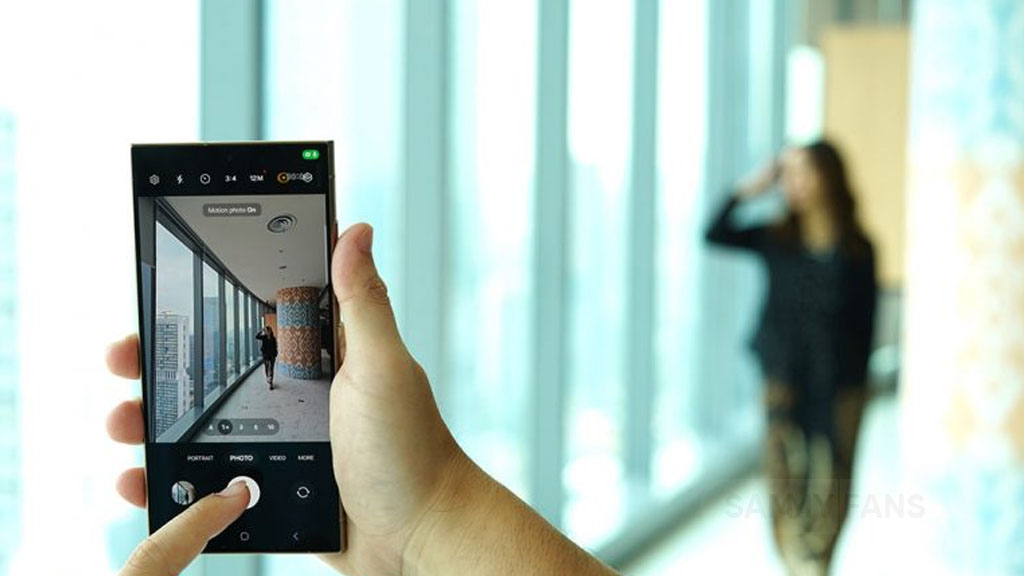
Samsung One UI 6.1 brings an amazing photography experience with its enhanced Motion Photo feature. This enhanced functionality arrives with the Galaxy S24 series with One UI 6.1 and offers users the ability to capture the best moments with unmatched precision and creativity.
With One UI 6.1 update, the enhanced Motion Photo feature is available on the Galaxy S23 series including S23 FE, Galaxy Z Fold 5, Galaxy Z Flip 5, and Galaxy Tab S9 series. It is soon available on Galaxy S22 series, Galaxy Z Fold 4, and Galaxy Z Flip 4 smartphones.
Motion Photo Feature
The Motion Photo feature of Samsung One UI 6.1 allows users to record a scene in a dynamic sequence of up to 90 frames, capturing a detailed 3-second preview before and after the shutter is pressed. This means you can pick the best photo from several options, even if you thought you missed the moment.
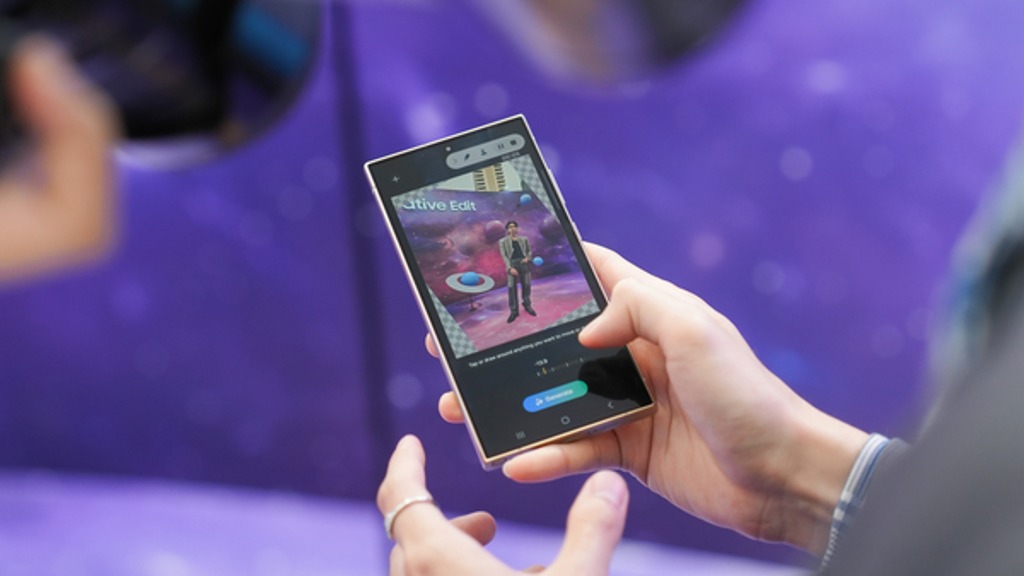
The Galaxy S24 Series’ camera is not just fast, it’s smarter and more intuitive. With a shutter speed that’s 30% quicker than the previous models, the ‘Faster Shot-to-Shot Shutter Speed’ capability of the Galaxy S24 series ensures you’re always ready to capture a candid scene.
The AI automatic enhancement feature refines the chosen frame, saving it as a high-resolution image with vivid details up to 12MP. Even in challenging lighting conditions, the Super High Dynamic Range (HDR) feature ensures your photos are clear and vibrant.
How to use the Motion Photo feature?
- Launch the Camera app
- Enable the Motion Photo feature by tapping on its icon.
- Click the shutter button as usual to take a photo
- Visit the Gallery and select your photo that has been successfully taken.
- Tap ‘View Motion Photo’ to explore the frames.
- Choose the best image in Motion Photo and apply ‘Quick Crop’.
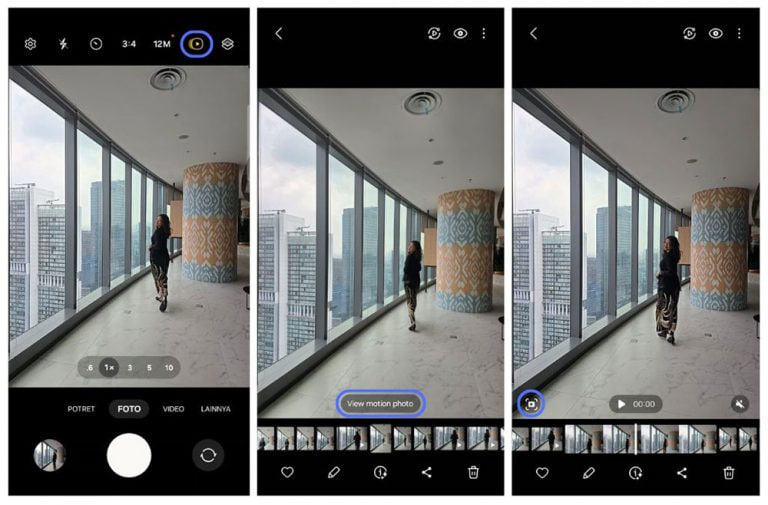
Stay up-to-date on Samsung Galaxy, One UI & Tech Stuffs by following Sammy Fans on X/Twitter. You can also discover the latest news, polls, reviews, and new features for Samsung & Google Apps, Galaxy Phones, and the One UI/Android operating system.
Do you like this post? Kindly, let us know on X/Twitter: we love hearing your feedback! If you prefer using other social platforms besides X, follow/join us on Google News, Facebook, and Telegram.
One UI 6.1
Samsung One UI 6.1 Intelligent Optimization Camera Feature
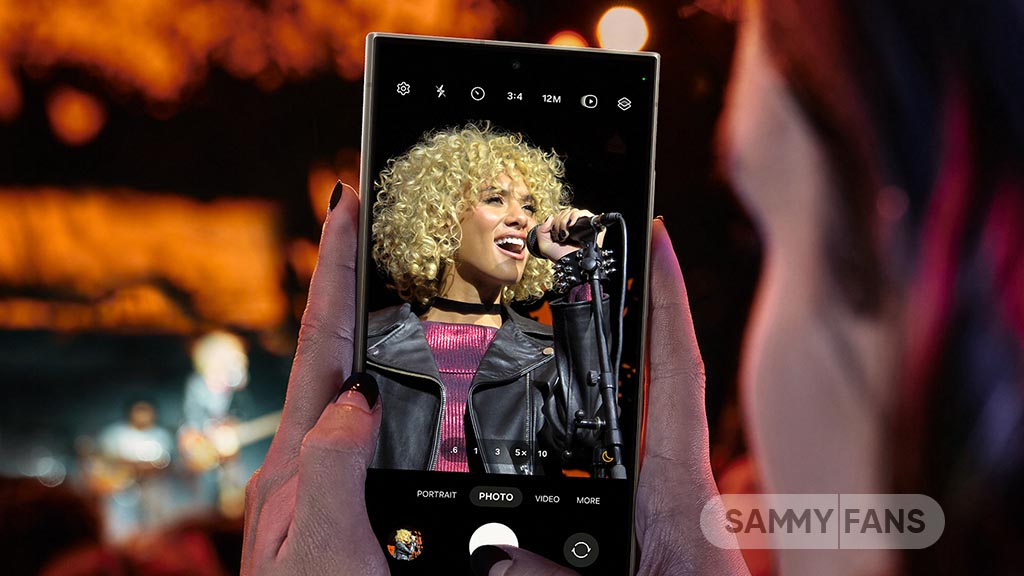
Samsung Galaxy S24 series introduced several new features and enhancements with the One UI 6.1, one of which is Intelligent Optimization. This feature is designed to give users specific control over the image processing levels directly from the camera settings.
The Intelligent Optimization feature allows users to adjust how their photos are processed. Whether capturing everyday moments or professional shots, the Intelligent Optimization feature in One UI 6.1 ensures that your photos meet your standards with minimal effort.
How to activate it?
You can easily enable the Intelligent Optimization feature by following the steps below.
- Open the Camera app, then Settings.
- Tap on Intelligent Optimization.
- Choose the desired optimization level
- Maximum
- Medium: Speed up capture time by doing less optimization
- Minimum: Take pictures as fast as possible by not optimizing pictures after they are taken.
- Optionally, enable or disable the Scene Optimizer.
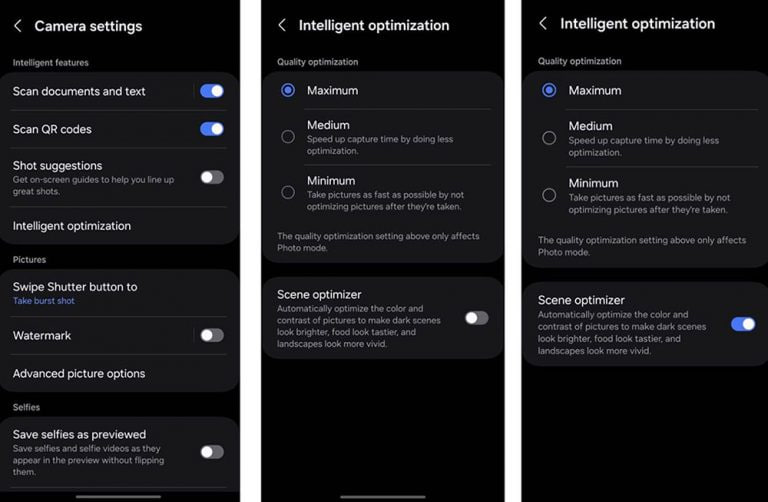
This feature allows for customization of photo attributes such as sharpness, contrast, and brightness. For example, selecting the minimum level results in more natural-looking images, while the maximum level increases detail and sharpness, which is ideal for zoomed-in shots. Notably, the quality optimization setting of these levels only affects Photo Mode.
If you enable Scene Optimizer, it automatically optimizes the color and contrast of pictures to make dark scenes look brighter, food looks tastier and landscapes look more vivid.
How to use One UI 6.1 Camera Shift feature on your Samsung Galaxy
Stay up-to-date on Samsung Galaxy, One UI & Tech Stuffs by following Sammy Fans on X/Twitter. You can also discover the latest news, polls, reviews, and new features for Samsung & Google Apps, Galaxy Phones, and the One UI/Android operating system.
Do you like this post? Kindly, let us know on X/Twitter: we love hearing your feedback! If you prefer using other social platforms besides X, follow/join us on Google News, Facebook, and Telegram.

